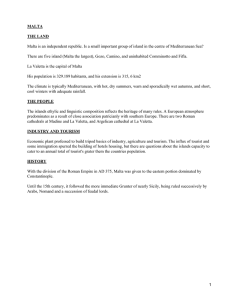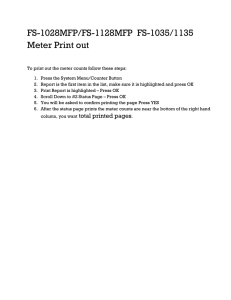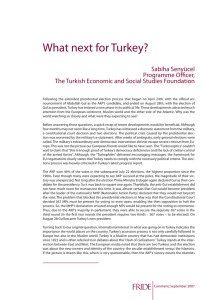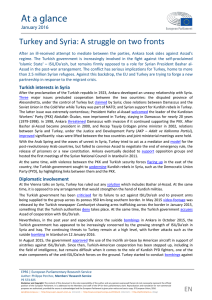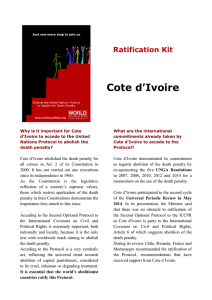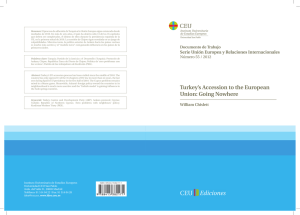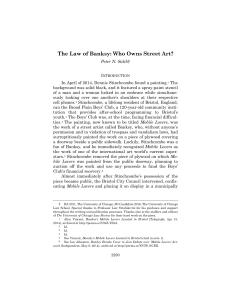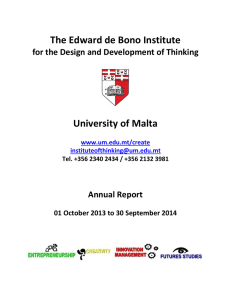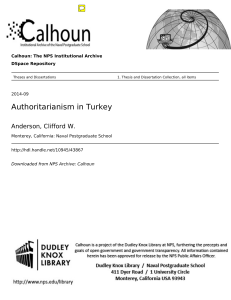Políticas económicas de la UE (Unión Europea)
Anuncio
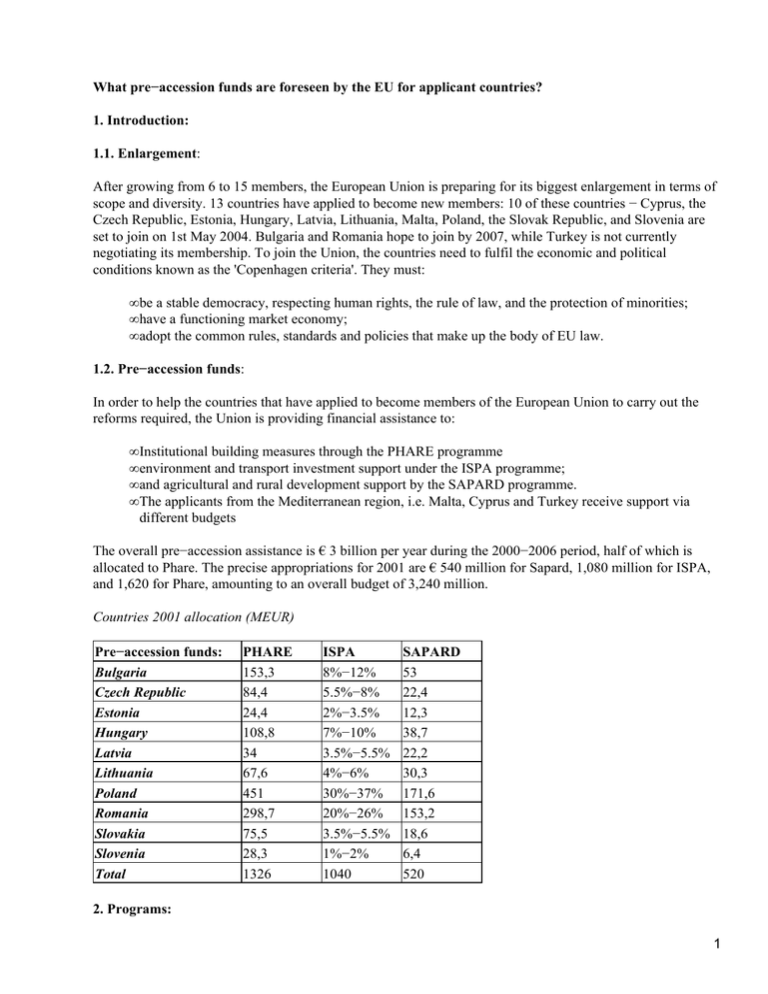
What pre−accession funds are foreseen by the EU for applicant countries? 1. Introduction: 1.1. Enlargement: After growing from 6 to 15 members, the European Union is preparing for its biggest enlargement in terms of scope and diversity. 13 countries have applied to become new members: 10 of these countries − Cyprus, the Czech Republic, Estonia, Hungary, Latvia, Lithuania, Malta, Poland, the Slovak Republic, and Slovenia are set to join on 1st May 2004. Bulgaria and Romania hope to join by 2007, while Turkey is not currently negotiating its membership. To join the Union, the countries need to fulfil the economic and political conditions known as the 'Copenhagen criteria'. They must: • be a stable democracy, respecting human rights, the rule of law, and the protection of minorities; • have a functioning market economy; • adopt the common rules, standards and policies that make up the body of EU law. 1.2. Pre−accession funds: In order to help the countries that have applied to become members of the European Union to carry out the reforms required, the Union is providing financial assistance to: • Institutional building measures through the PHARE programme • environment and transport investment support under the ISPA programme; • and agricultural and rural development support by the SAPARD programme. • The applicants from the Mediterranean region, i.e. Malta, Cyprus and Turkey receive support via different budgets The overall pre−accession assistance is € 3 billion per year during the 2000−2006 period, half of which is allocated to Phare. The precise appropriations for 2001 are € 540 million for Sapard, 1,080 million for ISPA, and 1,620 for Phare, amounting to an overall budget of 3,240 million. Countries 2001 allocation (MEUR) Pre−accession funds: Bulgaria Czech Republic Estonia Hungary Latvia Lithuania Poland Romania Slovakia Slovenia Total PHARE 153,3 84,4 24,4 108,8 34 67,6 451 298,7 75,5 28,3 1326 ISPA 8%−12% 5.5%−8% 2%−3.5% 7%−10% 3.5%−5.5% 4%−6% 30%−37% 20%−26% 3.5%−5.5% 1%−2% 1040 SAPARD 53 22,4 12,3 38,7 22,2 30,3 171,6 153,2 18,6 6,4 520 2. Programs: 1 2.1. Phare (Poland and Hungary: Action for the Restructuring of the Economy) Definition: Phare Programme is the main instrument of assistance for the candidate Central and Eastern European countries. Phare was set up in 1990 and originally, Phare was aimed at only two countries: Hungary and Poland. Objectives: Its purpose is to prepare the applicant countries for accession by concentrating on the two key priorities involved in the adoption of the Community acquis: • Institution−building (strengthening of administrative and institutional capacity of applicant countries) 30 % of the budget (including the twinning projects) • financing of investment projects (acquis−related Investment) 70% of the budget The Phare Programme has been endowed with EUR 1 560 million p.a. since 2000 and the effect of this has been enhanced by reformed management methods. 1. Priorty: Institution Building: develop the structures, strategies, human resources and management skills needed to strengthen their economic, social, regulatory and administrative capacity. A long−term tool to serve that purpose is the twinning of administrations and agencies. Current Member of the EU make their expertise available for the candidate countries implement the acquis by exchange of civil servants, expert missions, etc. It is a very pragmatic, case−by−case method of reforming public administration. During the 1998−2000 period, more than 270 twinning projects were approved. 2. Priority: Acquis−related Investment consists of two major types of activities: • Co−financing of investment in the countries' regulatory framework to strengthen the regulatory infrastructure needed to ensure compliance with the acquis. • Co−financing of investment in economic and social cohesion, initiated in Phare 2000 programmes, through measures similar to those supported in Member States through the European Regional Development Fund (ERDF) and the European Social Fund (ESF). This will promote the functioning of the market economy and the capacity to cope with competitive pressure and market forces within the EU. It will represent about one third of each Phare National Programme. Budget: Multi−annual indicative national allocations will be set by the Commission, based primarily on population and GDP per head but also taking into account past performance, need, absorption capacity and progress in implementing the Accession Partnerships. 2.2. ISPA: (Instrument for Structural Policies for Pre−Accession) Objectives: • Finances major environmental and transport infrastructure; (50/50 of the budget) • Accession−oriented, follows an approach similar to that of the Cohesion Fund This will include projects aimed at extending the Trans−European Transport Networks to provide good 2 connections between the Union and the applicant countries and interconnections between national networks The funding provides the development of railways (50% of the budget), roads (40 %), waterways/ports and airport infrastructure. Environmental infrastructure concentrates on drinking water, treatment of wastewater, solid−waste management and air pollution management. Similar to the Cohesion Fund. ISPA comes under the responsibility of the Regional Policy Directorate General. Budget: Has an annual budget of € 1,040 million for a period of seven years (2000−2006)surface area. On the basis of population, per capita GDP (in purchasing power parity terms) and land ISPA can finance only up to 75 % of project cost, though in some exceptional case it can be increased up to 85%. Co−financing is consequently needed (with the EIB, EBRD, the Nordic Investment Bank, the Nordic Environment Fund and national sources). The Commission wants to develop co−financing with IFI's and also with the private sector (Public/Private Partnerships). 2.3. SAPARD (the Special Accession Programme for Agriculture and Rural Development) Definition: Sapard aims to support the efforts made by the candidate countries to prepare for their participation in the Common Agricultural Policy and the Single Market. Sapard came into effect on January 1, 2000, and is budgeted until the end of 2006. It comes under the responsibility of former DGVI, now DG Agriculture and is implemented by national management authority. Objectives: • to help solve the priority and specific problems in agriculture and rural development, structural adjustment in the agricultural sectors of candidate countries. • to contribute to the implementation of the acquis communautaire (the whole body of Community legislation) concerning the CAP and other agricultural priorities. Budget: It has an annual budget of EURO 520 million and the criteria for allocation are farming population, agricultural area, GDP per capita in purchasing power, and the specific territorial situation in each country. 2.4. Pre−accession aid for Cyprus, Malta and Turkey 2.4.1. Cyprus and Malta: The fourth financial protocol (1995−98) was extended by one year, until 31 December 1999. In 1998, a sum of EUR 4.65 million was allocated. In 1999, the resources available increased to EUR 5 million. Council Regulation (EC) No 555/2000 lays down a financial reference amount of EUR 95 million for the implementation of operations in the framework of the pre−accession strategy for Cyprus and Malta (EUR 57 million for Cyprus and EUR 38 million for Malta). This amount will be available for the period up to 31 December 2004. In 2001, Malta received pre−accession aid totalling EUR 7.5 million. The amount allocated for 2002 was EUR 9.5 million. 3 Cyprus and Malta are eligible for loans from the European Investment Bank (EIB) and are participating in the MEDA regional programmes. 2.4.2 Turkey Between 1996 and 1999, Turkey received grants of EUR 376 million, over EUR 90 million per year. In 2001, EUR 194 million were set aside for aid to Turkey. In 2002, appropriations totalled EUR 149 million. The European Investment Bank (EIB) will provide Turkey with a total of EUR 6.425 billion for the period from 2000 to 2007. Turkey is eligible for five EIB−managed instruments: EuroMed II, the Mediterranean partnership facility, the special action programme for Turkey, the pre−accession facility and the earthquake rehabilitation and reconstruction assistance programme. Regulation (EC) No 2500/2001, published in December 2001, aims to refocus the Community's financial assistance to Turkey on the priorities set out in Turkey's Accession Partnership. Efforts will also concentrate on Turkey's cross−border cooperation and on its participation in certain Community programmes. The following actions may benefit from financing: improvement of infrastructure, protection of the environment, agricultural and rural development, stimulation of transport and energy networks, and removal of obstacles between border regions. The calls for tenders under the Phare , ISPA and SAPARD programmes are now open to Turkish firms. 4
